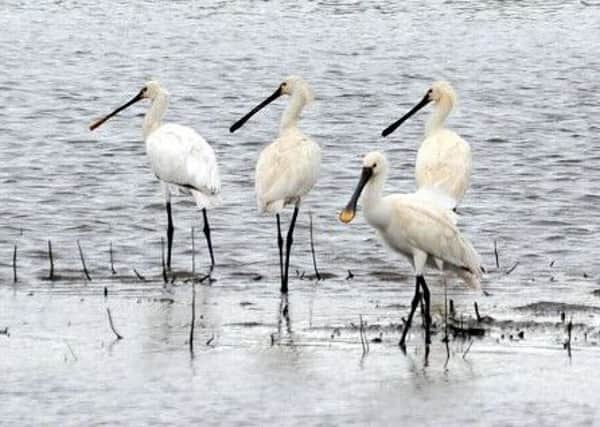Birdwatch: Hungry spoonbills on the hunt


Eight, a mix of sub adults and juveniles, two of which were ringed in Holland, were seen from the Marshland hide at the RSPB’s Blacktoft Sands reserve this week – a record for Yorkshire – while another was at the RSPB’s Saltholme reserve on Teesside.
They are dispersing from breeding sites and seek places with ample food supplies to help them build up to a good condition before their moult.
Advertisement
Hide AdAdvertisement
Hide AdSpoonbills feed by sweeping their partly open bills from side to side in the water and the moment any small crustacean or tiny fish touches the inside the bill it snaps shut.
They are returning as a regularly breeding bird in this country after some 350 years with a regular colony at the Holkham National Nature Reserve on the Norfolk coast. The colony was first established in 2010, the following year eight pairs fledged 14 young and numbers have continued to increase since then.
In July 2014 a record 30 spoonbills gathered at the Norfolk Wildlife Trust’s Cley Marshes reserve just along the coast from Holkham while in October that year a flock of 47, the largest ever recorded in Britain, was seen on lagoons at Brownsea Island in Poole Harbour, Dorset.
Pairs have also bred successfully in Lancashire and Scotland while across the North Sea numbers continue to rise in the Netherlands where there are now more than 2,300 pairs.
Advertisement
Hide AdAdvertisement
Hide AdThe majority of these nest on the Wadden Islands with a record 641 nests in the largest colony, on Texel, last year.
The majority of European spoonbills migrate south to the West African coast for the winter but a small number stay in Europe along the coasts of France, Spain and Portugal returning to breeding sites from early February.
Eyes have been on the skies around Wykeham, North Yorkshire after a short-toed eagle was reported by seven observers over fields to the north of the village on Saturday afternoon before flying off to the west.
There was also another possible sighting from the Wykeham raptor viewpoint on Monday. This species, normally found in southern Europe, was first recorded on the UK mainland at the Wareham Forest reserve in Dorset in May 2014 and subsequently seen in Ashdown Forest, East Sussex.
Advertisement
Hide AdAdvertisement
Hide AdWader numbers are increa-sing as the ‘autumn’ migration gathers pace with growing numbers, especially of dunlin, at Spurn, the first returning ruffs, 16 spotted redshanks and black tailed godwits at Blacktoft Sands, seven ruff at Swillington Ings, and a wood sandpiper at the North Cave Wetland.
Water levels are being lowered at a number of reserves to encourage the waders to stay a while. A glossy ibis was seen for several days at Arksey Ings, Doncaster while the little bittern was still being seen and heard on the Old Moor reserve near Barnsley.